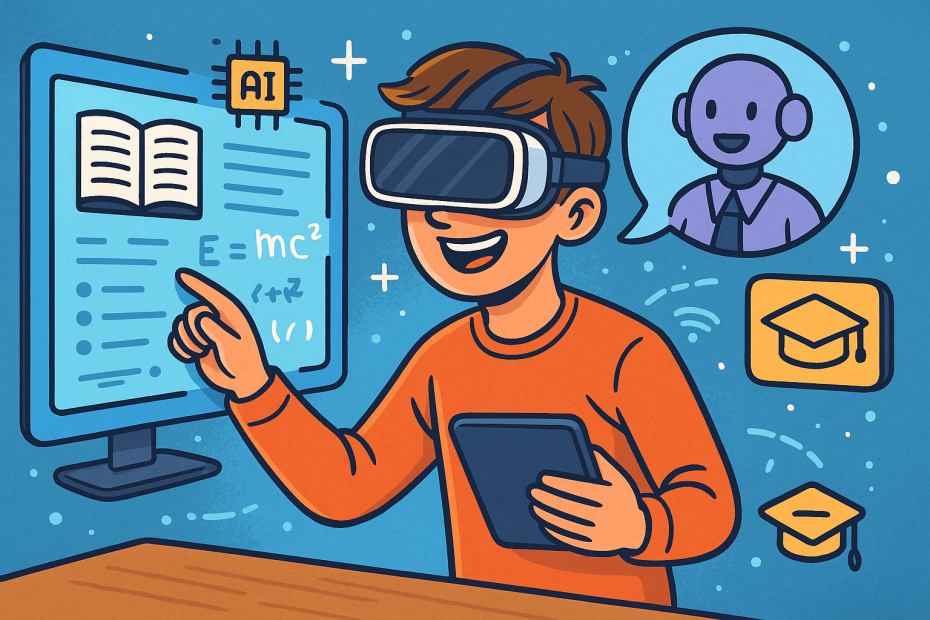You thought you cracked the education system when you figured out how to skim three chapters the night before an exam and still pass with a C+. Adorable. Technology saw that trick and said, “Not on my watch.” The way education is being transformed makes your “last-minute genius” method look like using a flip phone in the age of iPhones. Spoiler: the syllabus just got an upgrade, and you didn’t.
This article walks you through the comedy (and occasional tragedy) of how technology has stormed into classrooms, taken the chalk away, and is now running the show. Don’t worry—you’ll laugh, maybe cry, but mostly you’ll realize the future of learning is here, and you’re already enrolled.
Goodbye Chalkboards, Hello Smartboards
Once upon a time, teachers wielded chalk like wizards casting spells, complete with squeaks that could peel paint off the walls. Now, smartboards flash HD graphics, videos, and diagrams so slick they make your old geometry textbook look like cave art.
Of course, with every advance comes new chaos. Instead of broken chalk, you get broken Wi-Fi. Instead of eraser dust in the air, you’ve got that awkward silence as the teacher screams at the projector: “Why won’t you connect?!”
But hey, at least now you can watch a YouTube animation of photosynthesis instead of staring at stick figures on the board.
AI Tutors Who Never Sleep (Or Let You Off the Hook)
Private tutors used to sigh dramatically every time you forgot basic math. Now? AI tutors grin in digital silence and adjust the lesson like they’re dealing with a toddler trying to eat glue.
These platforms know your mistakes better than you do. Forgetting the Pythagorean theorem again? The AI will politely say, “Let’s review,” while silently screaming in binary. Unlike humans, they don’t get tired, don’t need lunch breaks, and don’t judge your SpongeBob pajamas at 2 a.m.
But don’t think you can cheat the system. AI is tracking your clicks, your hesitations, and probably your emotional breakdown when you see calculus. Creepy? Yes. Effective? Also yes.
VR and AR—Education Goes Full Sci-Fi
Forget permission slips and sad field trips with cold sandwiches. Virtual reality can plop you inside the Great Wall of China without leaving your swivel chair. Augmented reality can place a 3D beating heart on your desk while you’re still munching Doritos.
The immersion is incredible. You can dissect frogs without the smell. You can explore space without the motion sickness. You can tour the pyramids without heatstroke. Of course, you’ll still use it to play VR bowling instead of reviewing history timelines.
Teachers love VR because it makes students feel engaged. Students love VR because it makes skipping to TikTok easier when no one’s watching. Balance.
Personalized Learning—It’s All About You (Finally)
Gone are the days when thirty kids were force-fed the same material at the same pace like it was academic fast food. Now, tech tailors learning to your personal style. Slow? It waits. Quick? It challenges you. Lazy? It still drags you forward like an overachieving personal trainer.
This means no hiding in the back row pretending to understand. The system knows exactly how many times you clicked “replay” on that video about fractions. It knows your weaknesses, your strengths, and probably how often you daydream about snacks during math.
It’s like Spotify playlists but for your brain—except instead of “chill vibes,” it’s “stop forgetting long division.”
Inequality Isn’t Gone, It Just Got Wi-Fi
Tech promised equality. Reality? Some students get iPads and VR headsets, others get teachers asking if the printer has paper this century. Spoiler: it doesn’t.
The digital divide is real. High-speed internet and shiny devices mean some students learn quantum physics in middle school, while others can’t load Google Docs. It’s less about ability and more about who’s got better bandwidth.
Of course, governments and schools say they’re working on it. Until then, you’ll still hear the phrase “please turn in your homework” followed by “but I couldn’t connect.” A tale as old as time.
Where Tech Actually Nails It
- Interactive lessons that hold your attention longer than a cat video.
- Instant feedback instead of waiting weeks for grades.
- Access to global resources without leaving your couch.
- No more “lost homework” excuses. Sorry, it’s in the cloud.
Teachers Become Coaches, Babysitters, and IT Support
Teachers used to be the all-knowing sages standing at the front of the classroom. Now? They’re juggling roles like circus performers. They’re guiding personalized learning, monitoring devices, and acting as unpaid IT support when the smartboard goes feral.
They’re not less important—they’re more essential than ever. Only now, their job description reads more like “coach, mentor, Wi-Fi whisperer, part-time therapist, and professional password resetter.”
Credentials Get an Upgrade
Once upon a time, your diploma lived in a dusty drawer until job interviews. In the tech age, credentials are digital, portable, and permanent. Blockchain even makes your grades unhackable—so yes, that “C” in high school biology is now eternal.
Online certifications, micro-credentials, and badges are the new flex. Employers love them. Students love collecting them. But remember: no one’s impressed if you only earned “Beginner’s Guide to Turning on Zoom.”
Lifelong Learning—The Sequel You Didn’t Ask For
The final boss of modern education? It never ends. You don’t “graduate” anymore. You just unlock new levels. Certifications, online courses, micro-learning—it’s like Netflix for knowledge, except you can’t binge-watch your way to success.
You’re constantly reminded that if you stop learning, you’ll be outdated faster than a fidget spinner. Lifelong learning is the new survival skill. Congratulations: your summer breaks are gone forever.
How is Technology Changing Education?
- Personalized AI-driven learning tools
- Virtual and augmented reality classrooms
- Digital credentials and certifications
- Lifelong learning opportunities online
Welcome to the Era of “Forever School”
So here you are: no chalk dust, no nap time in class, and no excuse for ignorance. Education isn’t static—it’s a streaming service that updates daily, and unsubscribing isn’t an option.
You’ll stumble, reboot, and rage against Wi-Fi outages, but in the end, you’ll emerge sharper, faster, and maybe a little more sarcastic about AI correcting your spelling.
Final Advice: Don’t just adapt—own it. The future of education already has your login, and yes, it noticed your overdue assignments.
For more stories and strategies about the intersection of learning and technology, connect with me Behance. Let’s explore how the digital age is reshaping education—one AI tutor at a time.

Cassandra Toroian is a sports-tech entrepreneur and CEO/co-founder of Ruley, the AI “e-referee” serving tennis, pickleball, padel, golf, and soccer. With 25+ years building companies—and a background in finance (MBA) plus Python training—she’s also co-founder of Volleybird and author of Don’t Buy the Bull. A former Division I tennis player, she’s focused on using AI to make sport fairer and more accessible.

